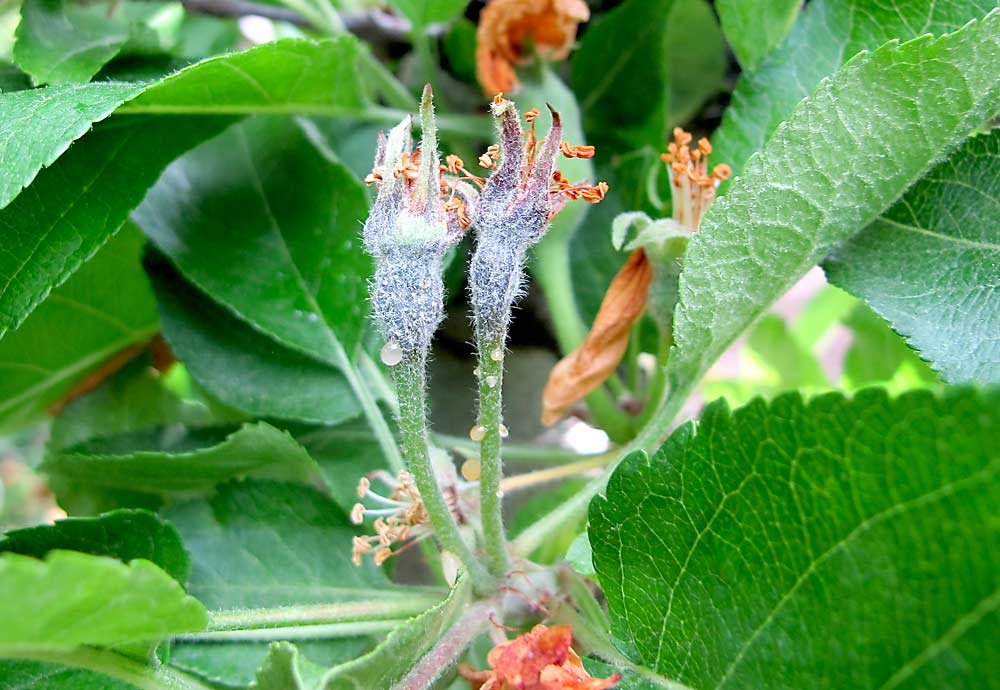
Growers today have more options than ever for controlling fire blight. But no antibiotic alternative checks all the boxes.
“There’s three things we want the (control) material to do,” said pathologist Ken Johnson of Oregon State University. “One is to significantly reduce the pathogen on the flower, and antibiotics are pretty good at that. The second goal would be good infection suppression. … And then the material has to have a low potential to mark the fruit.”
Antibiotics check all the boxes, he said, but alternatives often require growers to weigh trade-offs between protection and fruit marking — or accept inconsistent performance.
“What we find is that when we are going to apply a product, it works differently in North Carolina than in Michigan than in New York,” said Sara Villani, a pathologist at North Carolina State University.
To provide better insight into how to use the growing list of products labeled for fire blight, Johnson, Villani and colleagues from around the country teamed up to evaluate product performance under different climates, cultivars and systems, supported by a $5 million grant from the U.S. Department of Agriculture, building on work supported by the Washington Tree Fruit Research Commission.
While there’s still more to learn, especially about the plant defense-inducing products targeting shoot blight, the research team has gathered enough data to show how the different blossom blight options can best be assembled into a protective program and how much relative control growers can expect from different products.
The value of better fire blight management is huge for the industry, Villani said at the Fire Blight Fruit School, an educational workshop presented in Washington, Michigan and online earlier this year. Michigan growers lost some 400,000 trees along Fruit Ridge in 2000, when streptomycin resistance caught them by surprise. In Washington, growers who were surveyed about the impact of the 2018 outbreak (representing about 10 percent of the industry’s acreage) reported costs of $3.7 million for management and tree replacement on 17,000 acres, which can be extrapolated to an estimated $37 million in direct costs statewide.
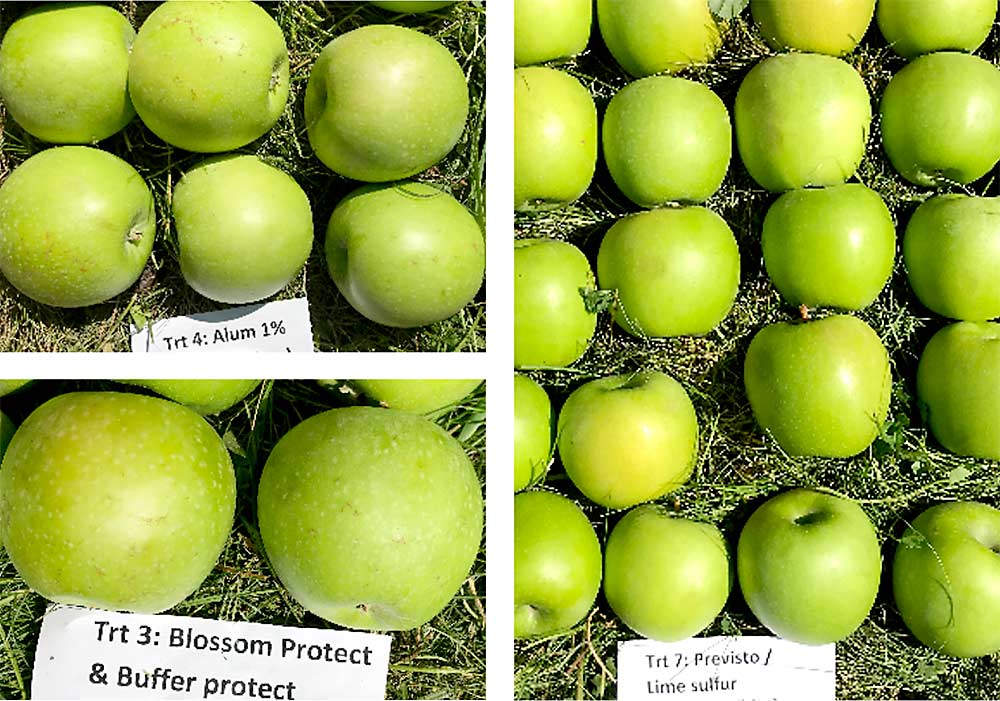
And in Western New York last year, “we just got pounded,” said Kerik Cox, a Cornell pathologist. “Right at petal fall, we get these really high temperatures, massive spikes, flowers are susceptible, shoots are growing, thinning is creating microwounds and, next thing you know, trees are collapsing.”
Products that looked great in 2021 trials, when pressure was mild, struggled in the hot, wet 2022 conditions, he said. That seasonal variation in disease pressure significantly hampers evaluation of fire blight control products. He cautioned growers to watch out for big error bars on charts — indicating inconsistency — and for product marketing based on just one year of data.
Pathology primer
Fire blight is a bacterial disease of apples and pears caused by the pathogen Erwinia amylovora. Each year, the disease cycle starts when temperatures warm enough to wake the pathogen, which overwinters in cankers. It begins to ooze. Wind, rain and insects then carry the bacteria to blossoms.
When it’s warm and humid, the bacteria multiply rapidly in the flowers, and unwitting pollinators spread them readily. This infection causes blossoms to ooze and then blacken while the pathogen moves into the vascular tissue, where it can spread through the tree and cause cankers and strikes (shoot infections).
Inside plant tissues, E. amylovora makes proteins that cause plant cells to explode, freeing up nutrients to the invaders, said Aina Baro, a postdoctoral researcher at Washington State University. As the bacteria colonizes the xylem vessels, it stops water flow, causing wilt.
Young shoots can be infected directly — if the pathogen enters through wounds — or from systemic infection. Infected shoots often appear wilted or develop a diagnostic “shepherd’s crook.” In young trees, this can be destructive or deadly.
Growers intervene to prevent this cycle by pruning out cankers in the winter and, if the block had high disease pressure the previous year, applying fixed coppers. During bloom, they avoid irrigating and track weather forecasts for high-risk conditions.
“We want to target our high-efficacy products 12 to 24 hours before high-risk events,” said Tianna DuPont, WSU tree fruit extension specialist and leader of Washington’s fire blight trials. Then, it’s important to continue protection programs for a week or two past petal fall, as pathogen populations can continue to build.
To manage shoot blight, growers prune out strikes. DuPont recommends cutting 12 to 18 inches below visible symptoms into 2-year-old or older wood.
Shoot blight management poses more of a concern in Eastern growing regions. To slow disease progression in shoots, growers can apply the plant growth regulator prohexadione calcium (Apogee, Kudos), which slows shoot growth and fire blight spread, as well as products that stimulate the tree’s own defense response, such as Actigard. Success with these products has been variable, depending on the orchard’s age and the disease pressure, Cox said.
For conventional growers who need to clean up after shoot infections, Johnson recommends painting concentrated Actigard onto trunks after strikes have been pruned out. It’s expensive, he notes, but could be worth the cost for young trees worth saving.
Biopesticides for bloom
The demand for antibiotic alternatives for fire blight control grew out of both streptomycin resistance and Washington’s organic production boom.
An ongoing WSU survey found no antibiotic-resistant strains in the state in 2022, said pathologist Frank Zhao. That’s good news, following growers’ efforts to reduce use of streptomycin. They apply it at most once a year, when tank-mixed with oxytetracycline, a different antibiotic with a different mode of action, to reduce the risk of selecting for resistance.
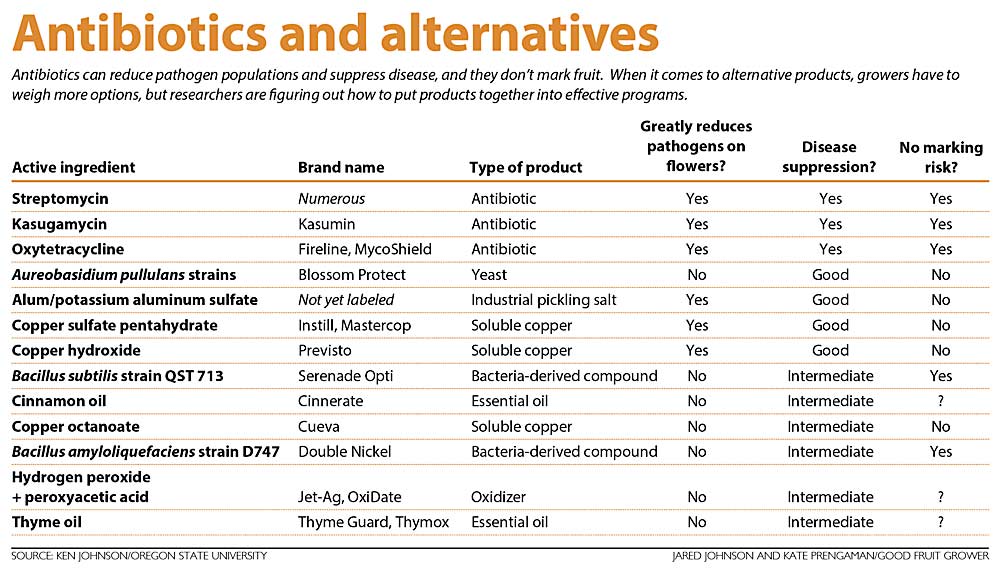
The term “biopesticide” is applied to many different types of alternative products, Johnson said, from living yeasts (Blossom Protect) or bacteriophages to bacteria-derived compounds (Serenade Opti or Double Nickel) to essential oils (Cinnerate or Thyme Guard). Other nonsynthetic chemicals are often lumped in, too, such as soluble copper products (Previsto, Mastercop) or oxidizers (Jet-Ag, OxiDate).
He prefers to call them all antibiotic alternatives, however, and some, such as Blossom Protect, have become the “foundation” of control in organic systems in the Western U.S., where the marking risk is usually manageable.
In repeated trials in Washington, Oregon, New York and Pennsylvania over the past decade, Blossom Protect, applied with Buffer Protect, offers what the researchers rate as “good disease suppression” similar to antibiotics — about 70 to 75 percent reduction in cluster infections. Some soluble coppers and alum, an industrial pickling salt that lowers the flower’s pH to an inhospitable degree, also consistently provide good disease suppression in multiple geographic regions.
Alum, which is mass-produced and cheap but not yet labeled for orchard use, seems to act like a soluble copper. With both, “you can really knock down the pathogen population,” Johnson said.
Trial results show a handful of products shaking out in a second tier, he said, offering some control but better used in addition to the top-tier products. Serenade falls in this category, as do two essential oils: thyme and cinnamon. Johnson puts oxidizing products, such as Jet-Ag and OxiDate, in this tier as well, as they offer a flash of bactericide action but not ongoing control.
Johnson said the industry continues to learn how best to use these products. Going forward, rather than researching how each performs alone, he’s interested in using “the specific properties of biopesticides in sequence to optimize our goals.”
This is how Johnson’s program looks, taking all the data into consideration:
—Starts with Blossom Protect at 80 percent bloom, which prevents bacteria from causing disease.
—Then, shortly after full bloom, he opts for Previsto or another soluble copper (keeping in mind that different products have different levels of active ingredient) “because it’s going to get after those building pathogen populations,” he said.
—At petal fall, fruit marking becomes more of a concern, so that’s the time to use Serenade Opti, which doesn’t cause marking. It doesn’t meaningfully reduce pathogen populations but seems to protect the floral cup “for a couple days and get us through the infection,” Johnson said.
This progression uses each product’s mode of action — protective Blossom Protect, clean-up coppers and defensive Serenade — at the optimum timing. This program, which he considers the organic standard, offers about 85 percent control, comparable to an antibiotic program.
“These are numbers we can live with,” he said, especially because that’s the control in an inoculated trial, where researchers are “coating trees with the fire blight pathogen.”
by Kate Prengaman
From research to recommendations
In a recent study, we evaluated nonantibiotic materials for fire blight control in eight Washington, three Oregon, three New York and two Pennsylvania field experiments conducted from 2013 to 2022 (DuPont et al. 2023).
In summary analysis of eight Washington trials, alum, Blossom Protect and several soluble copper products (Previsto, Mastercop, Instill) provided good disease suppression in the range of 70 to 73 percent, similar to antibiotic controls. Several essential oil, copper, oxidizing and biological products (Thyme Guard, Thymox, Cinnerate, Cueva, OxiDate 5.0, Jet-Ag and Serenade Opti) provided intermediate disease suppression ranging from 45 to 62 percent, significantly better than the water-treated control. In multistate trials, alum with two to three applications provided good control in most experiments (median 71 percent across eight experiments). Essential oils with three to four applications provided intermediate control (median 45 percent across four experiments).
Nonantibiotic fire blight control programs that contain Blossom Protect and soluble copper products during the bloom period (e.g., Previsto, Cueva) followed by Bacillus-based biorationals (e.g., Serenade Opti) at petal fall have performed well at suppressing fire blight infections with lower russet risk in Oregon trials from 2013 to 2021 (Johnson et al. 2022). Integrated programs with Blossom Protect and/or soluble coppers during high-risk bloom periods followed by essential oils or oxidizing products at petal fall have also had control similar, but not superior, to standard organic programs in several trials. Consider drying times, rotations and limit post-petal-fall applications to moderate russet risk of essential oils and oxidizing products.
—Tianna DuPont,
WSU ExtensionFor more information on the latest fire blight findings, visit: bit.ly/wsu-fire-blight and check out the research team’s two recent publications.
—DuPont, S. T., K. Cox, K. Johnson, K. Peter, T. Smith, M. Munir, and A. Baro. 2023. Evaluation of biopesticides for the control of Erwinia amylovora in Apple and Pear. Journal of Plant Pathology, Submitted February 2023 JPPY-D-23-00118.
—Johnson, K. B., T. N. Temple, A. Kc, and R. B. Elkins. 2022. Refinement of Nonantibiotic Spray Programs for Fire Blight Control in Organic Pome Fruit. Plant Dis. 106: 623-633.
‘New window into fire blight research’
Pathologists uncover a surprising mechanism for Blossom Protect.
Blossom Protect consistently ranks as one of the best antibiotic alternatives for blossom blight protection, but in trials comparing multiple products, Oregon State University pathologist and fire blight expert Ken Johnson noticed that flowers treated with the beneficial yeast still harbored a high pathogen population.
That was surprising, given the conventional wisdom that Blossom Protect (Aureobasidium pullulans) works by outcompeting the fire blight pathogen, Erwinia amylovora, within the flowers.
Johnson shared this data with colleague Quan Zeng, a pathologist at the Connecticut Agricultural Experiment Station, who specializes in the floral microbiome. They theorized that Blossom Protect may actually work by inducing the plant’s own immune response.
“As a plant pathologist, I always think about the disease triangle. For a disease to occur, you need the pathogen … the susceptible host, and conducive environmental conditions,” Zeng said. Since the yeasts did not seem to be attacking the pathogen or competing for space, “I thought, can we look at the host end?”
Plants have two main immune pathways that can be triggered: systemic acquired resistance (SAR) and induced systemic resistance (ISR); each turns on different immune response genes to help fight off infection. Zeng set up a greenhouse experiment, treated half the potted trees with Blossom Protect, and then extracted the RNA from floral tissues. RNA can be used to see what genes are activated, and Zeng wanted to see if the yeast triggered any immune response.
He found that Blossom Protect highly induced a group of immune genes, known as PR genes, in the SAR pathway. If that sounds familiar, it’s the same immune pathway triggered by Actigard (acibenzolar-S-methyl), which growers use for shoot blight.
Interestingly, the fire blight bacteria attacks and tries to suppress the same suite of immune genes in order to aid its proliferation into plant tissues, Zeng said. Treating flowers with E. amylovora alone lowers the immune gene expression; treating flowers with both Blossom Protect and the fire blight pathogen results in a level of immune response that is lower than the yeast alone but still much higher than the pathogen alone.
“When you only treat flowers with Blossom Protect, you significantly induce those PR genes. You prime up those host immune genes,” he said. “Then, the pathogen comes and tries to suppress them, but they are so high the pathogen fails.”
That priming takes time. Zeng found that the immune response peaks two days after Blossom Protect application and lasts at least four days. But the immune response appears to be local to each flower treated, not systemic.
Understanding this mechanism should help growers maximize the use of Blossom Protect, which Johnson calls “the foundation” of any nonantibiotic program. But, in years or varieties with high russet risk, growers may want to remove the yeast after it has done its work. Oxidizers and late lime sulfur at petal fall are both effective for fire blight and remove Blossom Protect.
When the window of blight susceptibility is closing, and the window of potential fruit marking is opening, that’s good information to have, Johnson said.
Zeng and Johnson are seeking additional funding to study this approach, which they call “protection and clearing.” Zeng thinks russeting may be linked to how the yeast degrades the cuticle layer — damage that the flower perceives before triggering the immune response. Clearing the yeast off after it does its protective work may minimize, but not eliminate, the fruit marking risk.
Zeng also plans to employ the same genes as genetic markers to screen other apple flower-colonizing yeasts that may similarly trigger immune responses and suppress fire blight but show reduced russeting potential.
“It’s a new window into fire blight research,” Johnson said.
—by Kate Prengaman

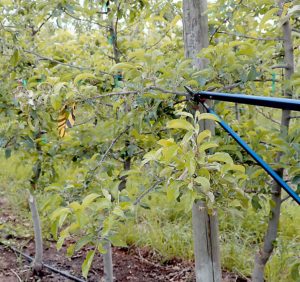
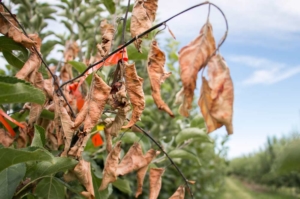





Leave A Comment